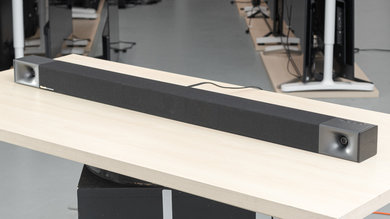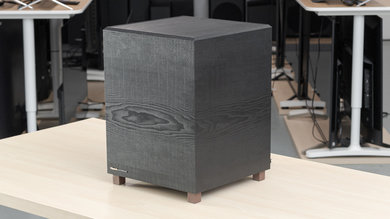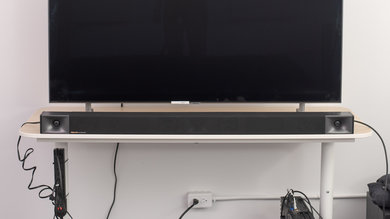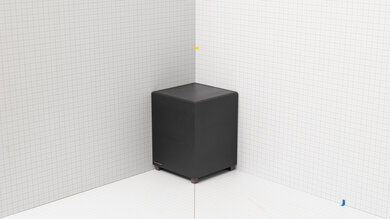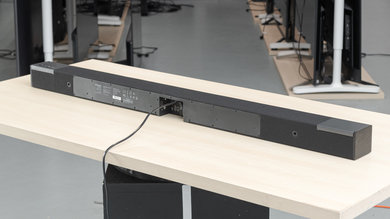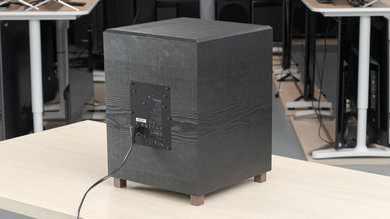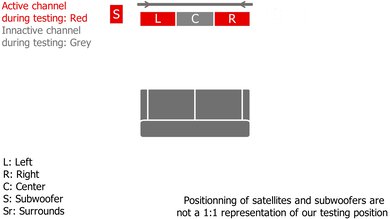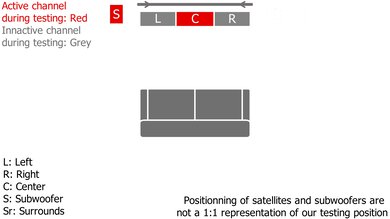Our Verdict
Mediocre for mixed usage. The Klipsch Bar 48 has a bright sound profile that won't be great for bass-heavy music and movies. It also lacks support for height channels, and won't give you an immersive listening experience since it's going to downmix surround sound content. The Bar 48 soundstage is also a bit disappointing and fairly narrow. It will perform best with stereo voice-oriented content like podcasts and audiobooks.
- Decently well-built.
- Discrete center channel.
- Stylish wooden design.
- Lacks bass.
- Poor surround performance.
- Few connection options; no HDMI In inputs
Decent for dialogue and TV shows. This soundbar has a fairly bright sound profile that lacks bass but performs accurately in the mid-range. It can also get very loud and supports a Dialogue Enhancement feature to get an even better listening experience, especially at lower volumes. You can also stream content from a smart device easily via Bluetooth, like podcasts and audiobooks.
Mediocre for music. This soundbar has a very bright sound profile. Although it has a subwoofer, it lacks sub-bass and is overall disappointing with music, especially with bass-heavy genres. Its soundstage is also smaller than the bar and won't compare to tower speakers. While it can get very loud, which is good for large rooms and crowded environments, the Bar 48 distorts and doesn't reproduce a clean sound, even at a normal and moderate listening volume.
Mediocre for movies. The Klipsch Bar 48 lacks bass and won't give you an immersive feel as it doesn't do well with surround channels. The soundstage is also fairly narrow and it doesn't have height channels. All 5.1 content will be downmixed to stereo due to its 3.1 configuration. It also lacks a room correction feature, so it might perform differently depending on your room. On the upside, it does fairly well with content on the center channel due to its discrete localization.
Changelog
- Updated Mar 30, 2021: Converted to Test Bench 1.0.
- Updated Sep 27, 2019: Review published.
Check Price
Popular Soundbar Comparisons
The Klipsch Bar 48 stands aside by its unique design and looks rather than its performance. Unfortunately, even with a dedicated subwoofer, it lacks bass and its overall performance is quite disappointing. See our recommendations for the best soundbars, the best soundbars with a subwoofer, and the best soundbars 5.1.
The Klipsch Cinema 600 is a better soundbar than the Klipsch Bar 48. The Cinema 600 has a more neutral sound profile and a better soundstage performance. However, the Bar 48 is better built.
The Sonos Arc is better than the Klipsch Bar 48. The Sonos is a 5.0.2 setup, is better built, and supports Atmos content. It has better soundstage and surround performances and built-in voice assistant support. It even comes with some more sound enhancement features, like room correction. However, the 3.1 Klipsch comes with a dedicated sub, and it reproduces a more extended low-bass.
The Klipsch Cinema 800 is better than the Klipsch Bar 48. The Cinema 800 supports Dolby Atmos content, unlike the Bar 48. The Cinema 800 also has a better soundstage and a more neutral sound profile out-of-the-box. However, the Bar 48 is better built.
Even without the sub and satellites, the Sonos Beam is a better soundbar than the Klipsch Bar 48, which has a dedicated subwoofer. The Sonos is smaller, well-built, and has a more neutral sound profile. Also, its soundstage is wider and has more sound enhancement features. On the other hand, the Bar 48 can get noticeably louder.
Test Results

The Klipsch Bar 48's bar has a unique style. Its front and top are covered in a mesh-like fabric that can get easily dirty or damaged. The two ends of the bar contain the speakers and are made of solid plastic. The two sides have a wooden cover. You can choose between brown and black covers, as both are included in the box. The buttons that control the bar are found on the top of the right speaker, along with a very small screen.
The bar is rather wide and it won't fit between the legs of the stand of any 55" TV. Because of this, you'll have to place it in front, and you might need a wider table. It isn't too tall and won't obstruct the view of your screen unless you have a TV that sits flush on the table, like the Sony A9F.
The Klipsch Bar 48's build quality is decent. Its bar is mainly covered with fabric that can easily get damaged or dirty, and the speakers are enclosed in solid plastic on the sides and have a wooden decorative cover. You can choose between brown and black covers, as both are included in the box. Although the subwoofer is wooden, the entire setup doesn't look very premium. Nevertheless, we don't expect you to have any issues with its build quality.
The Klipsch Bar 48's stereo frequency response is mediocre. This setup, which has a subwoofer, lacks a good amount of bass and the bass range isn't that extended. This results in a disappointing lack of thump and punch. Its sound profile is on the bright side and is slightly uneven. This won't be ideal for movies and bass-heavy music genres.
When listening to the Klipsch Bar 48, the soundstage feels just okay and slightly disappointing. The bar is fairly wide, but the soundstage doesn't sound very large. On the upside, the soundstage is focused and not diffused, which is good because objects seem to be coming from a more accurate pinpoint location rather than a general area. For a soundbar with a better soundstage, check out the Klipsch Cinema 600.
The Klipsch Bar 48 is a very loud soundbar, which is great for use in large rooms or crowded environments. Unfortunately, there's a bit of audible compression at max volume. However, its performance is still good considering how loud it gets, especially compared to other 3.1 soundbars we've tested, like the LG SN6Y.
The Klipsch Bar 48's THD performance is excellent at a normal listening volume (around 80dB) and the bar won't produce audible harmonic distortion. However, when pushed at max volume, there's a jump in THD, especially in the bass and mid ranges.
This Klipsch soundbar setup has an excellent center channel performance on surround content. Due to its 3.1 configuration, the Bar 48 has a dedicated center speaker, which results in a more clear and accurate audio reproduction of the dialogue in movies. However, the general sound profile is still a bit bright because it lacks bass, but there isn't much bass on center channels, to begin with, so this shouldn't matter too much.
Performance is quite poor when sending surround content to this bar. The 3.1 Bar 48 downmixes surround sound content, resulting in poor localization, which doesn't sound as real as a discrete localization. This means that sound will feel like it's coming from the front instead of getting an immersive listening experience. The sound profile is fairly dark and bass-heavy, and the bar has bad distortion at max volume.
This soundbar setup doesn’t have height channels and doesn’t support Atmos. For a soundbar with height channels, see the TCL Alto 9+ or the Klipsch Cinema 800.
The Klipsch Bar 48 has sub-par support of sound enhancement features. It's missing Room Correction, which means this soundbar may sound differently depending on your room. There's also no way of customizing your sound profile to your liking, unlike other soundbars like the Samsung HW-T650 or the Klipsch Cinema 400. On the upside, you have a Dialogue Enhancement feature to make voices clearer and an Auto-Volume/Night mode to uniformize the level of different types of content you listen to. You can also easily adjust the amount of bass coming from the subwoofer, which could be useful for some considering that by default, the Bar 48 lacks bass.
The Bar 48 has a very basic set of physical inputs. It has the common Optical In so it can receive 5.1 surround sound, but it's limited to one shared HDMI port between HDMI ARC and HDMI out. On the upside, you can connect older mp3 players or your phone using the soundbar's Analog Audio In port, and it can also decode files on a USB stick.
Over ARC, the Klipsch Bar 48 only supports the Dolby Digital and the DTS formats which, however, allow the bar to decode content with surround sound. These formats are the most common ones, and most content on streaming platforms or Blu-rays is encoded using one of them. If you're looking for a 3.1 soundbar that can support eARC and Dolby Atmos content, check out the LG SN8YG.
There's no Full HDMI In in this soundbar setup. Because of this, the more advanced audio formats can’t be reproduced.
Both sound formats that are usually passed through Optical are supported. As long as you use an optical connection, you shouldn't have issues with content that supports Dolby Digital or DTS, so you'll be able to decode surround sound.
The soundbar can connect to modern devices using its Bluetooth connection. This makes it easy to enjoy music from your phone or tablet.
Unfortunately, due to the lack of Full HDMI In, you can't use this soundbar as a hub for your other devices.
The soundbar doesn’t support any assistance natively. You can use Google Assistant from your phone, and if you're connected to the soundbar using Bluetooth, the sound will come from the bar.
No app pairs with the Klipsch Bar 48 soundbar. For a similar 3.1 soundbar that has a dedicated app, check out the LG SL6Y.
Unlike most soundbars, there's no sleep or auto-off feature, which can be annoying at times especially if you care about saving energy and you forget to power it off. On the upside, the bar supports HDMI CEC, so you can have some basic control from your TV remote.

